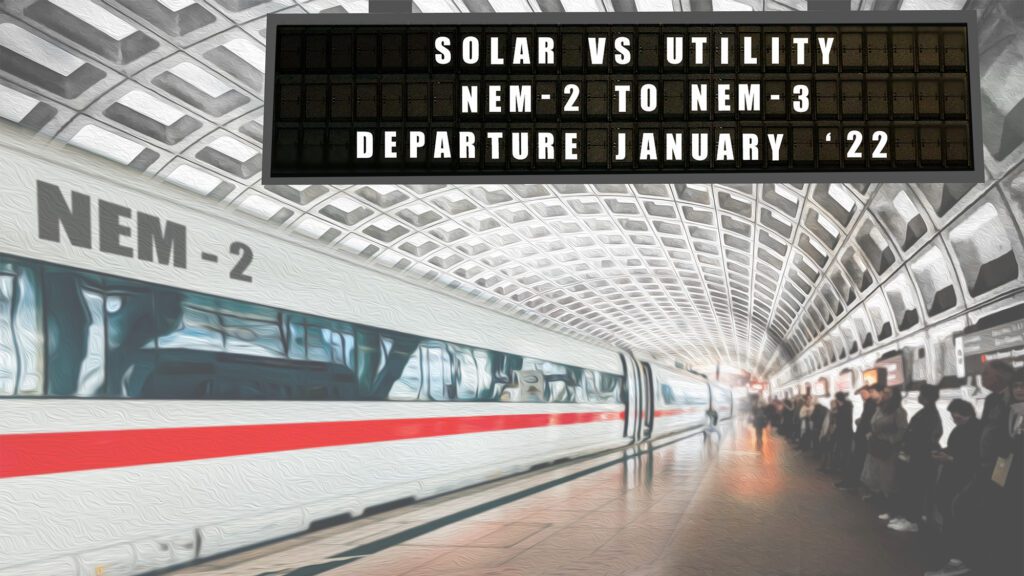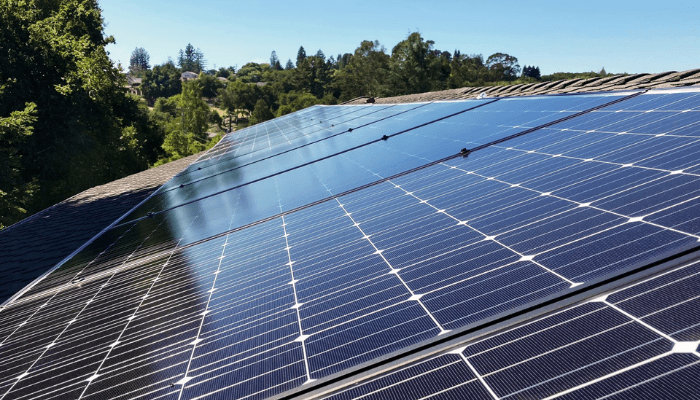Net Energy Metering (NEM) is revolutionizing how solar energy users interact with the power grid. It allows consumers to send excess solar power back to the grid, offsetting their energy costs. But what happens during periods of decreased solar production? That’s where battery storage systems can play a crucial role storing surplus solar energy for use during off-peak hours or power outages, enhancing energy independence.
In California, the introduction of NEM 3.0 has reshaped the net metering landscape. This has impacted the financial returns of solar investments. This guide delves into the intricacies of net energy metering and battery storage systems. We will explore the implications of NEM 3.0 and strategies to maximize savings. For a quick understanding of how NEM works, check out this earlier post “What is Net Metering” comparing the process to a farm, eggs, and a PiGgEe farmer or read on below.
Understanding Net Energy Metering (NEM)
Net energy metering is a billing mechanism that connects solar energy users with the utility grid. When your solar panels generate more electricity than you consume, the surplus is fed back into the grid. Then you receive credits on your energy bill.
Benefits of Net Energy Metering
- Financial Savings: Reduces electricity bills by offsetting energy costs.
- Compensation: Ensures solar users are credited for the excess energy supplied to the grid.
- Promotes Sustainability: Encourages the adoption of renewable energy sources.
The Role of Battery Storage in Solar Energy Systems
Home battery storage systems are essential components of modern solar installations. They keep extra solar energy made when the sun is shining the most. This energy can be used at night, on cloudy days, or during power outages.
Advantages of Battery Storage
- Energy Reliability: Provides uninterrupted power supply during grid outages.
- Cost Savings: Allows use of stored energy during peak utility rate periods, reducing reliance on the grid.
- Enhanced Energy Independence: Reduces dependency on PG & E.
PG&E usually buys power from you at a lower price than what they sell it for. A battery storage system will give you the best return on your investment. The California Public Utilities Commission (CPUC) website states the following:
“The value of the export compensation (which the IOUs term “Energy Export Credits”) is usually lower than the retail rate, but can rise above the retail rate on late summer evenings. Customer-generators can maximize bill savings under the NBT by installing battery storage along with their generation, so they can use or export stored energy during these high-value hours.” – Link
Peak demand usually happens from 4 PM to 9 PM. During this time, solar energy is not very effective, especially in winter. You buy energy at a high rate. During the day, when your solar panels make a lot of energy, any extra energy you have is bought from you at a lower rate. A home battery storage system can help fix this problem. It stores extra energy you make during the day. You can use this stored energy later. This reduces the need to buy costly energy from PG&E.
NEM 3.0 in California: What You Need to Know
California’s NEM 3.0 represents a significant update to the state’s net metering policy, affecting how solar customers receive credits for excess energy. Understanding net metering California policies will help you make an informed decision on how to install residential solar and commercial solar.

Key Changes from NEM 2.0 to NEM 3.0
- Adjusted Compensation Rates: Surplus energy is now compensated based on the cost of energy at different times, emphasizing time-of-use (TOU) rates. California’s updated net metering policy has reduced the value of solar energy credits for PG&E customers by approximately 75%
- Time-of-Use Rates Emphasis: Encourages energy consumption and storage during off-peak hours when electricity is cheaper.
- Installation Requirements: New qualifications for solar installations to participate in net metering.
Impact on Solar Investment and ROI
While the changes may affect the financial returns of solar projects, strategic planning—such as incorporating battery storage systems and optimizing energy use—can still yield favorable returns on investment.
Maximizing Savings with Net Metering and Battery Storage
Combining net energy metering with battery storage systems can significantly reduce electricity costs. Good management of energy use and production is important for saving money.
Understanding Time-of-Use (TOU) Rates
TOU rates vary depending on when electricity is used. By using stored solar energy during peak rate periods, you can minimize utility charges.
Strategies for Energy Consumption Management
- Optimize Energy Use: Shift high-energy activities to off-peak hours.
- Smart Home Technologies: Use automation to align energy consumption with lower TOU rates.
- Monitor Usage Patterns: Regularly review energy consumption to identify saving opportunities.
Net Energy Metering Bay Area
Net metering policies can vary across different utilities and jurisdictions in the Bay Area. It’s crucial to understand your PG&E’s net metering program to maximize benefits. Check out the solar billing plan page by PG&E outlining the program and the short animated video they made.
Consumers Energy Net Metering Programs
Participation in net metering programs can provide substantial savings. Research the specific requirements and incentives offered by your utility provider.
Comparing Policies
Comparing net metering policies in different regions can help you understand the most favorable conditions for solar adoption and optimize your energy strategy.
The Future of Net Energy Metering and Battery Storage
Advancements in technology and evolving policies are shaping the future of net energy metering and battery storage systems.
Technological Advancements
- Improved Battery Storage: Innovations lead to more efficient and affordable battery systems.
- Smart Energy Management: Enhanced software for better control over energy production and consumption.
Policy Developments
Staying informed about policy changes, like NEM 3.0, is essential to adapt and continue maximizing the benefits of solar investments. Utilize resources like the California Public Utility Commission’s NEM webpage.
Embracing the Benefits of NEM and Battery Storage
By integrating net energy metering with battery storage systems, homeowners and businesses can achieve energy independence, financial savings, and contribute to environmental sustainability.
Key Takeaways
- Energy Independence: Reduced reliance on the grid enhances resilience.
- Financial Savings: Strategic energy management maximizes ROI.
- Environmental Impact: Supports the transition to clean energy sources.
FAQs About Net Energy Metering and Battery Storage
What is net energy metering? Net energy metering allows solar panel users to send excess energy back to the grid, receiving credits that reduce their electricity bills.
How does battery storage work with solar panels? Battery storage systems store surplus solar energy for use during times when solar production is low or during power outages.
What are the benefits of combining net metering with battery storage? Combining net metering with battery storage maximizes energy efficiency, increases savings, and enhances energy reliability.
How will NEM 3.0 affect solar users in California? NEM 3.0 introduces changes in compensation rates and billing structures, affecting the financial returns for solar users.
Can I still save money with net metering under NEM 3.0? Yes, by leveraging time-of-use rates and optimizing battery usage, users can continue to achieve significant savings.
What should I consider when choosing a battery storage system? Consider factors like storage capacity, cost, compatibility with your solar system, and professional installation services.
How can I stay informed about changes in net metering policies? Here at Synergy Power, our goal is not just to install solar panels in the Bay Area, but also to provide valuable information to help educate the community. Check out Synergy Power blog for more helpful articles and content or follow us on social media. Ready to get a quote on solar installation in the Bay Area? Contact us here.



